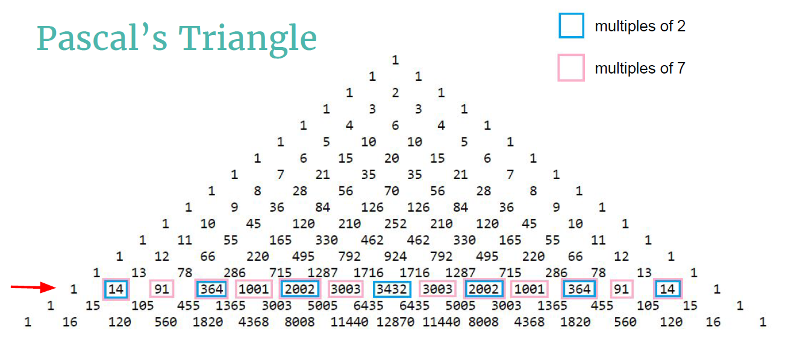LaTeX4Web 1.4 OUTPUT
We can visualize Condition 1 using Pascal
¢s Triangle. We fix some n and then we look at the n
th
row of Pascal¢s Triangle. We want to see if it is true that we can find two primes p and r such that if we paint the multiples of p in the nth
|
row with one color and the multiples of r in the nth
|
row with another color, then all the numbers in the nth
|
row are painted either with one of the colors, the other, or both (ommiting the ones in the edges). The following picture illustrates this explanation with n=14, p=2 (blue) and r=7 (pink).
LaTeX4Web 1.4 OUTPUT
In this page we will talk about some cases in which we can prove that n satisfies Condition 1. In the section "Fixing one prime" we provide code and information for when we fix p or r to be a certain prime. In the section "All possible pairs" we evalute given n how many pairs of primes make n satisfy Condition 1. In the section "Multinomials" we study the generalization of Condition 1 for the multinomials. Finally, in the section "OEIS sequences" we give code and explanations for proofs in which certain n satisfy Condition 1, in which we find two sequences that the On-line Encyclopedia of Integer Sequences has published.
LaTeX4Web 1.4 OUTPUT
First of all, Lucas¢ Theorem is a very useful theorem regarding the divisibility of binomial coefficients. It states the following:
Theorem. (Lucas) Let m and n be positive integers and let m = mkpk
|
+ mk-1pk-1
|
+ ... + m1p + m0 and n=nkpk
|
+ nk-1pk-1
|
+ ... + n1p + n0 be the base p expansions of m and n respectively. Then, C(m,n) º Õi=0k
|
C(mi,ni) mod p. It is important to notice that by convention C(m,n) = 0 if m < n. Now we can prove the following statement: Proposition. A positive integer n satisfies the 1-variation of Condition 1 with p if n=pa
|
for some a>0. Proof: The base p representation of n is equal to 10¼0 with a zeroes. Any k such that 1 £ k £ n-1 has at most a -1 zeroes in base p. Therefore, at least one of the digits of the base p representation of k is bigger than the corresponding digit of n in base p. It then follows from Lucas¢ Theorem that C(n,k) is divisible by p. Otherwise if n is not a prime power and hence some digit of n in base p is not zero we can find at least one k such that C(n,k) is not divisible by p.
LaTeX4Web 1.4 OUTPUT
From the previous proposition we can derive the following corollary: Corollary. If n=pa
|
+ 1, then p and any prime factor of n satisfy Condition 1. Proof: The proof relies on the fact that C(n,k)+(n,k+1) = C(n+1,k+1) for all positive integers n and k. If n is a power of a prime p, then it follows from the last proposition that C(n+1,k) is divisible by p if 2 £ k £ n-1. When k=1 or k=n, we have that C(n+1,k) = n+1, so any prime factor of n+1 divides it.
LaTeX4Web 1.4 OUTPUT
We can also prove the following proposition: Proposition. If a positive integer n is equal to the product of two prime powers p1a
|
and p2b
|
, then n satisfies Condition 1 with p1 and p2. Proof: Observe that lcm(p1a
|
,p2b
|
) = n. The base p1 representation of n ends in a zeroes and the base p2 representation of n ends in b zeroes. Because any positive k smaller than n cannot be divisible by both p1a
|
and p2b
|
, we can apply Lucas¢ Theorem modulo the prime p1 if p1a
|
does not divide k or modulo the prime p2 if p2b
|
does not divide k.
| 
